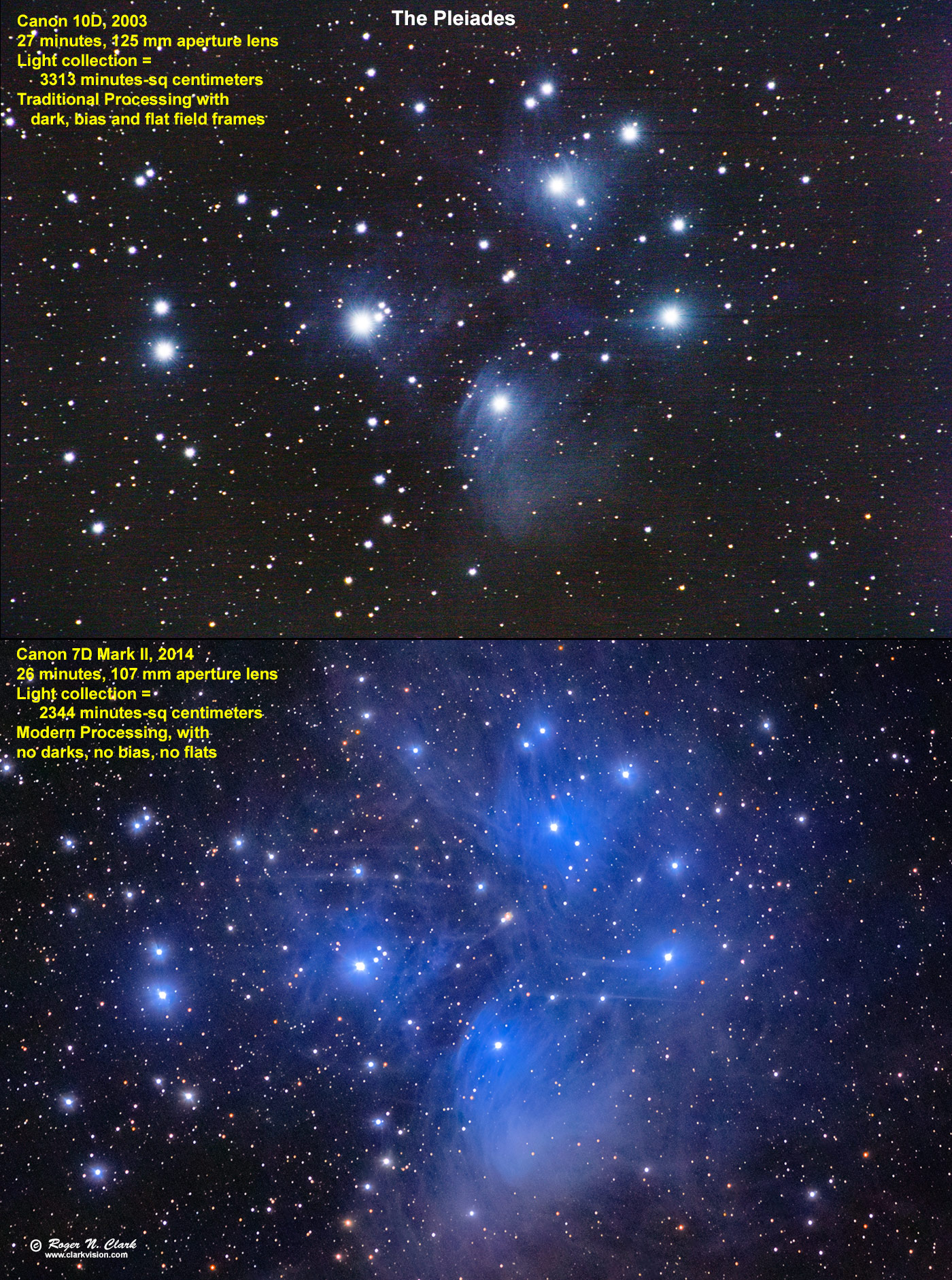| Home | Galleries | Articles | Reviews | Best Gear | New | About | Contact | Gallery Index | Previous |
Next |

| Home | Galleries | Articles | Reviews | Best Gear | New | About | Contact | Gallery Index | Previous |
Next |

The Pleiades star cluster, also known as the Seven Sisters is immersed in nebulosity due to scattered starlight near the cluster.
This two-panel image shows the impact of changing technology, both in camera sensors and in post processing software. The top image was made in 2003 and included the full traditional workflow using dark, flat, and bias frames. The traditional work flow also included the usually skipped color matrix correction. This traditional workflow was redone with the Canon 10D data in 2023 to be sure that things I learned over the years was included in the processing. The bottom image used a 2014 vintage camera with a modern workflow, with no dark, no flat, and no bias frames measured. The modern workflow used a more sophisticated raw converter that produced a sharper image with less noise. But the processing was done in 2014, so did not include things I learned from 2014 to 2023, thus giving an advantage to the Canon 10D processing. The 2014 camera has the new pixel design with On-Sensor Dark Current Suppression Technology that the 2003 camera did not have. The earlier sensor technology had higher dark current, more pattern noise (including banding), more pseudo-pattern noise, and lower quantum efficiency. The pattern noise and pseudo-pattern noise (patterns that shift from frame to frame) meant that the banding and amp glow (e.g. bright right edge) is not completely corrected by the dark and bias frame subtractions.
The technical advancements from 2003 to 2014 in both sensor tach and in software algorithms (especially raw conversion algorithms) shows major improvements, allowing better images with simpler acquisition and post processing.
Technical, Upper Panel. The image was made using a Canon 10D 6-megapixel digital camera, released in 2003, with a 125 mm aperture lens to acquire 27 one-minute exposures (27 minutes total exposure time), ISO 400. Darks: 25, flats: 10, bias: 10. The Canon 10D has 7.4 micron pixels, and 2.18 arc-seconds per pixel for the full resolution image.
Light collection per pixel = lens aperture area * exposure time * pixel angular solid angle.
Canon 10D light collection = (pi/4) * (12.5^2) * 27 * (2.18^2) = 15747 minutes-cm2-arc-seconds2.
Technical, Lower Panel. The image was made using a Canon 7D Mark II 20 megapixel digital camera and 107 mm aperture lens to acquire 26 one-minute exposures at ISO 1600 (26 minutes total exposure). No dark frame subtraction, no flat fields, no bias frames measured or used. Tracking with an astrotrac. The Canon 7D2 has 4.09 micron pixels, 2.81 arc-seconds per pixel for the full resolution image.
Canon 7D2 light collection = (pi/4) * (10.7^2) * 26 * (2.81^2) = 18460 minutes-cm2-arc-seconds2.
The lower frame, Canon 7D2 image, had 18460 / 15747 = 1.17, or 17% more light per pixel, thus a square root (1.17) = 8% advantage in signal-to-noise ratio. However, it is obvious the the Canon 7D2 image is far better than the 10D image. There is about a 7 to 8 times improvement in the Canon 7D2 signal-to-noise (S/N) ratio on the Merope nebula, and more for the fainter nebulae. To achieve similar S/N as in the 7D2 image, the 10D would need at least 50 times longer exposure! But the longer exposure would have more noise from dark current, thus much longer than 50x would be required.
To learn how to obtain stunning images like this, please visit my Extensive Articles on Photography .
See my review of the Canon 7D Mark II and why it is so good for astrophotography: Canon 7D Mark II sensor analysis.
Keywords to this image = astrophoto-1 star_cluster nebula Messier night low-light digital_astro canon_7d2 canon_10d
Image ID: pleiades.m45.rnclark.2014-tech-vs-2003-tech.a.jpg
| Home | Galleries | Articles | Reviews | Best Gear | Science | New | About | Contact |
Last updated April 02, 2025